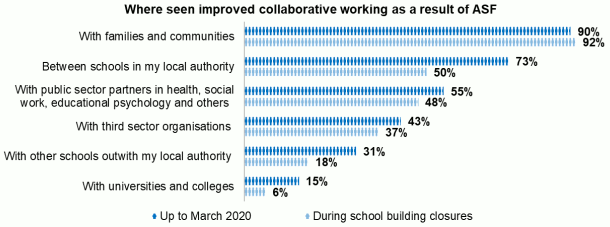Attainment Scotland Fund Evaluation - Headteacher Survey: 2020 report
The Attainment Scotland Fund Evaluation: Headteacher Survey – Full Report 2020 presents key findings from the fifth survey of headteachers of schools in receipt of Attainment Scotland Fund (ASF) support, covering the 2019/20 academic year including the period of school building closures from March.
6. Collaborative working
6.1. This section summarises views on whether and how ASF support has contributed to an increase in collaborative working.
6.2. The majority of headteachers had seen an increase in collaborative working in their school up to March 2020 as a result of ASF support. Nearly 2 in 3 (65%) indicated this, including more than a third (36%) who had seen a large increase in collaborative working as a result of the fund. This was broadly consistent with 2019 survey findings, although the proportion reporting increased collaboration has fallen from a peak of 77% in 2017.
6.3. A substantial proportion of headteachers indicated that they had seen a further increase in collaborative working during school building closures between March and June 2020; 46% indicated this.
6.4. Survey findings show some variation in school experiences around collaborative working. In particular, primary schools and those in rural areas were less likely to have seen an increase in collaborative working – up to and during the period of school building closures.

6.5. In terms of types of collaborative working, schools were most likely to have seen an increase in collaboration with families and communities, and other schools in their local authority. This applied both to the period up to and during school building closures, although survey results suggest that fewer schools were able to continue to improve collaboration with other schools during school building closures (50%, compared with 73% prior to closures). In contrast, 92% were able to continue to improve collaboration with families and communities during school building closures.
6.6. Survey findings show some variation in experience of collaboration across key respondent groups. This was particularly notable for collaboration with third sector organisations; Challenge Authority schools, secondary schools, and those in urban areas or small towns were most likely to have built collaborative working with third sector organisations.

6.7. Headteachers were asked to provide comment outlining any new collaborations that have emerged during the period of school building closures. The main points raised by respondents are summarised below.
| Theme | % of comments |
|---|---|
| With third sector organisations and community groups | 37% |
| With public sector organisations, particularly health and social care, mental health services | 21% |
| With other schools, primarily local cluster | 20% |
| With families and communities | 16% |
| With private sector organisations | 5% |
| With universities and colleges | 1% |
6.8. New or improved collaboration with third sector organisations and community groups was the most common (referenced by more than a third of those providing comment). This included reference to national charities such as Barnardo’s and Action for Children, local voluntary organisations including a particular focus on those supporting families affected by poverty (e.g. foodbanks, financial inclusion services, addressing digital poverty), Citizens’ Advice, and local religious groups.
6.9. Around a fifth of those providing comment referred to new or improved collaboration with public sector organisations. This included schools working with NHS services (reference to specific services including mental health services and speech/language therapy), social work services, Community Learning & Development, housing services, local authority financial inclusion services, and Police Scotland.
6.10. A substantial number of those providing comment also referred to new or improved collaboration with other schools. This was most commonly closer working with local cluster schools, including some noting that this had been supported by input from the local authority. It was also noted that increased use of remote meeting software to support remote learning had also helped to support closer collaboration with other schools.
Contact
Email: Fiona.Wager@gov.scot
There is a problem
Thanks for your feedback